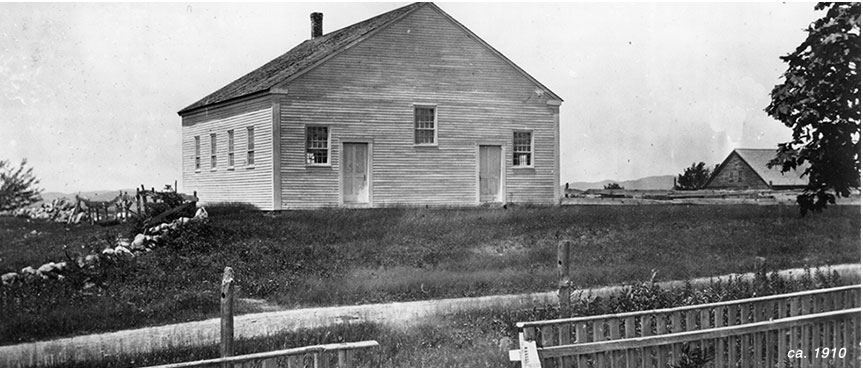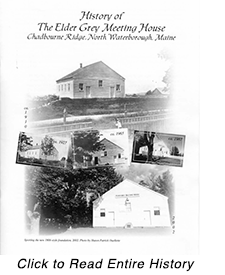

Meeting House Has Fascinating History
 In 1806 a church was built at the foot of Little Ossipee Pond in North Waterborough. Nothing is known of the first pastor, but one of the early ones was Elder James Gray, born in Coxhall [now Lyman, Maine] in 1784. On December 31, 1807, he married Anna Woodard; they moved to Waterborough in 1813. He was affiliated with the Henry Hobbs Church at Ossipee Hill and was ordained a Free Will Baptist preacher in 1825. The Meeting House gets its name from Elder Gray (or Grey), who served as pastor for many years.
In 1806 a church was built at the foot of Little Ossipee Pond in North Waterborough. Nothing is known of the first pastor, but one of the early ones was Elder James Gray, born in Coxhall [now Lyman, Maine] in 1784. On December 31, 1807, he married Anna Woodard; they moved to Waterborough in 1813. He was affiliated with the Henry Hobbs Church at Ossipee Hill and was ordained a Free Will Baptist preacher in 1825. The Meeting House gets its name from Elder Gray (or Grey), who served as pastor for many years.
In 1832 the Meeting House was moved to its present site in order to be nearer the aging pastor, who lived some two miles away, and possibly to accommodate the growing number of families who were living on the hills and ridges to the north of this area. Men and oxen brought the building to the top of the Ridge and, according to local legend, "they ran out of hay for the oxen, ran out of rum for the men and the building got mired in the mud." They felt they had met the pastor "half way." In those days Joseph and Samuel Bradeen, brothers, owned farms on opposite sides of the road. Joseph gave the site where the Meeting House was placed, and Samuel gave land across the road for the cemetery.
During foundation restoration work in the spring of 2000, Arron Sturgis, of Preservation Timber Framing, Inc., observed that the front peak is slightly bowed forward and concluded that the Meeting House came up the long, steep hill backwards.
 In 1854, at the age of sixty-nine, Elder Gray died. On June 26, 1854, Mary Lovina Chadbourn wrote to her sister, Joann Chadbourn Wells:
In 1854, at the age of sixty-nine, Elder Gray died. On June 26, 1854, Mary Lovina Chadbourn wrote to her sister, Joann Chadbourn Wells:
Elder Gray died very suddenly a week ago last Saturday. He was taken sick the Monday before...went outdoors the day he died. He went into his room to lay down, in a few minutes his wife went into the room and found him dead. It appeared that he died asleep, but most people think he died in a fit. The Doct. said he had symptoms of apoplexy.
Elder James Gray is buried with his wife across the road from the Meeting House in the cemetery that bears his name.
Following the pastorate of Elder Gray, Elder Buzzell, born in Parsonsfield in 1807 and ordained in 1834, became pastor. He served his people well and was later a chaplain in the Civil War. During this period, according to church records, "a great blessing of God succeeds our last association in Waterborough which a few—a very few years ago was a vast, howling wilderness." This refers to the great religious revival that occurred there. Of this revival, Elder Gray is quoted as saying, "I cut and piled, and cut and piled, and Brother Buzzell came along and touched the match to it."
In February 1857, a committee "desirous of preserving the House where our fathers have worshiped (known as the Eld. Grey Meeting House)" was formed to receive subscriptions and superintend repairs. The committee consisted of Albert N. Chadbourn, Ivory Chadbourn, Charles B. Mills, William Bradeen, and Harrison L. Strout. Records of collected monies and value of donated work were kept.
The Atlas of York County, Maine—1872 shows the Meeting House as a Union Church.